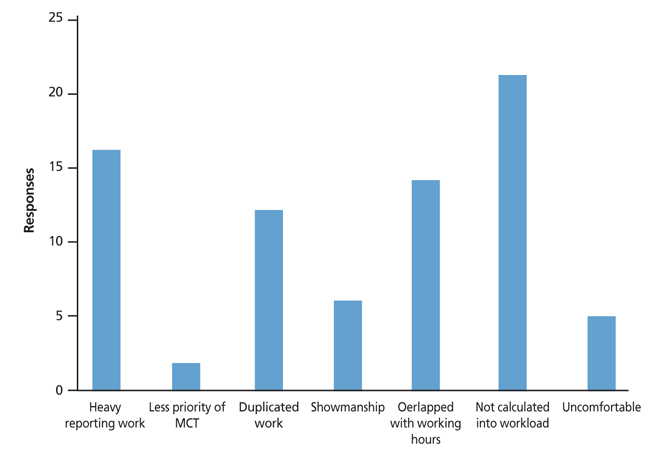J Korean Med Assoc.
2016 Feb;59(2):114-118. 10.5124/jkma.2016.59.2.114.
The role of radiologists for multidisciplinary cancer care
- Affiliations
-
- 1Department of Radiology and Center for Imaging Science, Samsung Medical Center, Sungkyunkwan University School of Medicine, Seoul, Korea. jeongwk@gmail.com
- 2Department of Radiology and the Research Institute of Radiology, Asan Medical Center, University of Ulsan College of Medicine, Seoul, Korea.
- 3Department of Radiology, Seoul St. Mary's Hospital, The Catholic University of Korea College of Medicine, Seoul, Korea.
- KMID: 2153716
- DOI: http://doi.org/10.5124/jkma.2016.59.2.114
Abstract
- In the multidisciplinary cancer treatment (MCT), it is necessary that radiologists participate in the patients' care, and they might be directly involved to the new practice methods including outpatient clinics. Face-to-face MCT is the most desirable practice method because satisfaction and compliance of the patients is high. However, it should be restrictively expanded due to practical problems such as lack of manpower. As a practical alternative, there is non-face-to-face MCT, like a tumor board, and it has many advantages to overcome the limitations of face-to-face MCT. Therefore, it is necessary to establish policies to support that both two types of MCT are stimulated so that the patients are able to get the optimized cancer management.
Keyword
MeSH Terms
Figure
Cited by 1 articles
-
Multidisciplinary team approach in cancer care
Young-Woo Kim
J Korean Med Assoc. 2016;59(2):86-87. doi: 10.5124/jkma.2016.59.2.86.
Reference
-
1. Balasubramaniam R, Subesinghe M, Smith JT. The proliferation of multidisciplinary team meetings (MDTMs): how can radio-logy departments continue to support them all? Eur Radiol. 2015; 25:3679–3684.
Article2. Burton S, Brown G, Daniels IR, Norman AR, Mason B, Cunningham D. Royal Marsden Hospital, Colorectal Cancer Network. MRI directed multidisciplinary team preoperative treatment strategy: the way to eliminate positive circumferential margins? Br J Cancer. 2006; 94:351–357.
Article3. Forrest LM, McMillan DC, McArdle CS, Dunlop DJ. An eva-luation of the impact of a multidisciplinary team, in a single centre, on treatment and survival in patients with inoperable non-small-cell lung cancer. Br J Cancer. 2005; 93:977–978.
Article4. Kesson EM, Allardice GM, George WD, Burns HJ, Morrison DS. Effects of multidisciplinary team working on breast cancer survival: retrospective, comparative, interventional cohort study of 13 722 women. BMJ. 2012; 344:e2718.
Article5. Morris E, Haward RA, Gilthorpe MS, Craigs C, Forman D. The impact of the Calman-Hine report on the processes and outcomes of care for Yorkshire's colorectal cancer patients. Br J Cancer. 2006; 95:979–985.
Article6. MERCURY Study Group. Diagnostic accuracy of preoperative magnetic resonance imaging in predicting curative resection of rectal cancer: prospective observational study. BMJ. 2006; 333:779.7. Hricak H, Choyke PL, Eberhardt SC, Leibel SA, Scardino PT. Imaging prostate cancer: a multidisciplinary perspective. Radiology. 2007; 243:28–53.
Article8. Travis WD, Brambilla E, Noguchi M, Nicholson AG, Geisinger KR, Yatabe Y, Beer DG, Powell CA, Riely GJ, Van Schil PE, Garg K, Austin JH, Asamura H, Rusch VW, Hirsch FR, Scagliotti G, Mitsudomi T, Huber RM, Ishikawa Y, Jett J, Sanchez-Cespedes M, Sculier JP, Takahashi T, Tsuboi M, Vansteenkiste J, Wistuba I, Yang PC, Aberle D, Brambilla C, Flieder D, Franklin W, Gazdar A, Gould M, Hasleton P, Henderson D, Johnson B, Johnson D, Kerr K, Kuriyama K, Lee JS, Miller VA, Petersen I, Roggli V, Rosell R, Saijo N, Thunnissen E, Tsao M, Yankelewitz D. International association for the study of lung cancer/american thoracic society/european respiratory society international multidisciplinary classification of lung adenocarcinoma. J Thorac Oncol. 2011; 6:244–285.
Article9. Kane B, Luz S, O'Briain DS, McDermott R. Multidisciplinary team meetings and their impact on workflow in radiology and pathology departments. BMC Med. 2007; 5:15.
Article10. Pitman AG, Jones DN. Radiologist workloads in teaching hos-pital departments: measuring the workload. Australas Radiol. 2006; 50:12–20.
Article11. Richardson B, Preskitt J, Lichliter W, Peschka S, Carmack S, de Prisco G, Fleshman J. The effect of multidisciplinary teams for rectal cancer on delivery of care and patient outcome: has the use of multidisciplinary teams for rectal cancer affected the utilization of available resources, proportion of patients meeting the standard of care, and does this translate into changes in patient outcome? Am J Surg. 2016; 211:46–52.
Article12. Khan SH, Hedges WP. Workload of consultant radiologists in a large DGH and how it compares to international benchmarks. Clin Radiol. 2013; 68:e239–e244.
Article
- Full Text Links
- Actions
-
Cited
- CITED
-
- Close
- Share
- Similar articles
-
- Requirements to improve multidisciplinary cancer care
- The role of pathologists in multidisciplinary cancer care
- Review on history and current practices of cancer multidisciplinary care
- An analysis on medical expenses of multidisciplinary cancer care under health insurance
- Multidisciplinary care service: issues raised so far and possible solutions suggested






